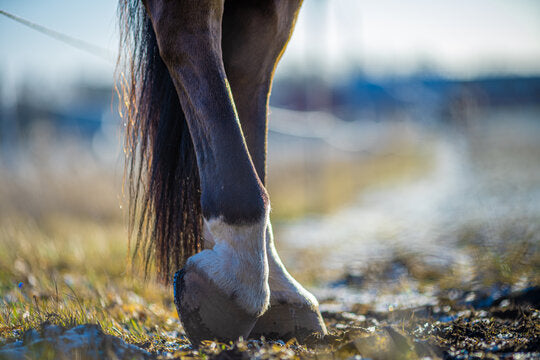Horse hoof care through every life stage
March 17, 2021

Published: March 2021 | Updated: July 2023
A horse’s hoof care needs will likely change over the course of his lifetime, and knowing what to expect, as well as how to care for the feet each step of the way, is important. Continuing on with our hoof health series, we’ll share more great information from equine podiatrist, Dr. Scott Fleming, of Rood and Riddle Equine Hospital-- this time focusing on providing horse hoof care tips throughout the major life stages.
Performance Horse Hoof Care Tips
Assuming a young horse didn’t start out with angular or flexural deformities, the most common time to first apply shoes is when training begins. Though not every horse may need shoes, depending on what they’re being asked to do, they can be helpful for protection on hard surfaces, as well as getting traction on softer surfaces.
According to Fleming, many people first apply shoes when a horse is going into their two-year-old year, in other words, “when their activity is necessitating protection.”
While a horse is in training or performance, Fleming says the main goal is to minimize hoof distortions of any kind and try to keep the foot as healthy as possible. Mimicking the barefoot horse, even with a shoe on, is always a good idea according to Fleming. This can be done by ensuring that the frog stays as low to the ground as possible in order to get stimulation in the back of the foot.
“Even though it's a shod foot, the goal is to make the hoof the healthiest version of itself through that shoeing,” says Fleming.
Broodmares and Stallions
Fleming recommends keeping broodmares and stallions barefoot, if at all possible. However, if they’ve come off the track or training of any kind and have been in shoes for a while, they may need a transition period before they can be fully sound without shoes.
“If they lose the shoe or if they've had some hoof wall quality issues already, then that can be tough in terms of sole depth,” says Fleming. “It's common for us to use a glue-on shoe that gives some sole protection and just gives them the ability and time to build some sole depth and some wall quality until we can get them back to being barefoot horses.”
In most cases, breeding animals do just fine without shoes, but they will need routine trimming to keep their feet maintained.
Shoes on the Senior Horse
Horses in their late teens or twenties can have unique hoof care needs, but like breeding animals, they still need routine farrier visits even if they aren’t in shoes.
An older horse may have slower hoof growth due to nutritional deficiencies from poor dentition or other issues. They may develop cracks or have poorer hoof quality than they once did.
Switching to a senior horse feed and/or supplements designed for the older horse can make an impact on the health of the feet, but one thing to watch out for is the sugar/carbohydrate content in feeds; choose one with a lower NSC value, especially if the horse is insulin resistant or has Pituitary Pars Intermedia Disorder (PPID).
“Laminitis and the things that can trigger that condition can be more common as a horse ages,” says Fleming.
No matter the life stage of your horse, there’s no substitute for a healthy diet and good management (including routine dental care and quality hoof attention), but understanding how a horse’s needs may change over time can help you keep your horse at his best.

